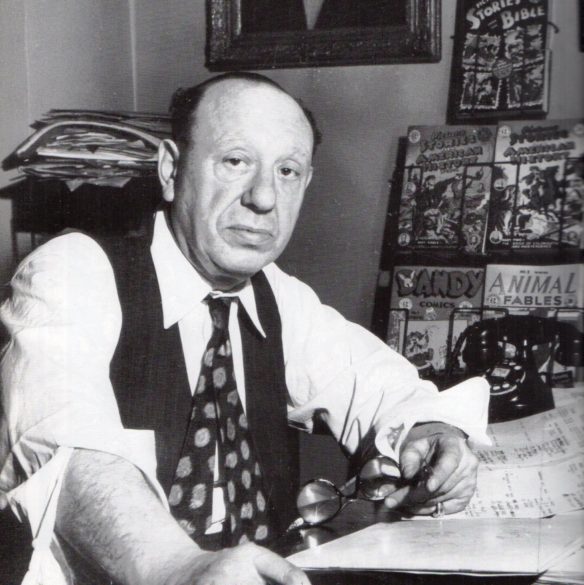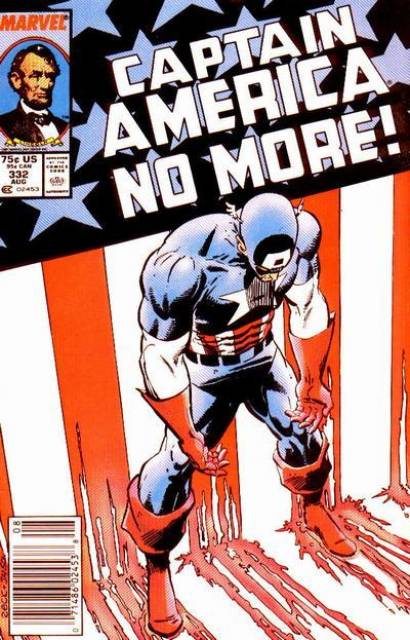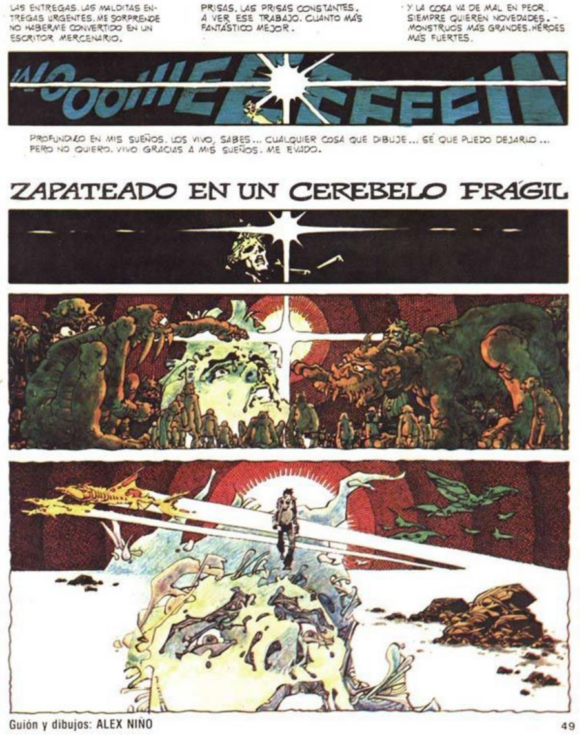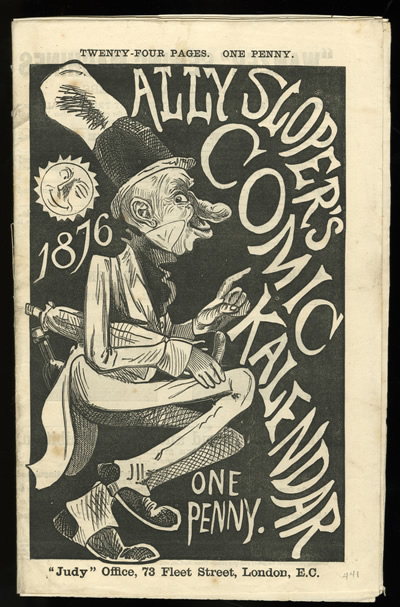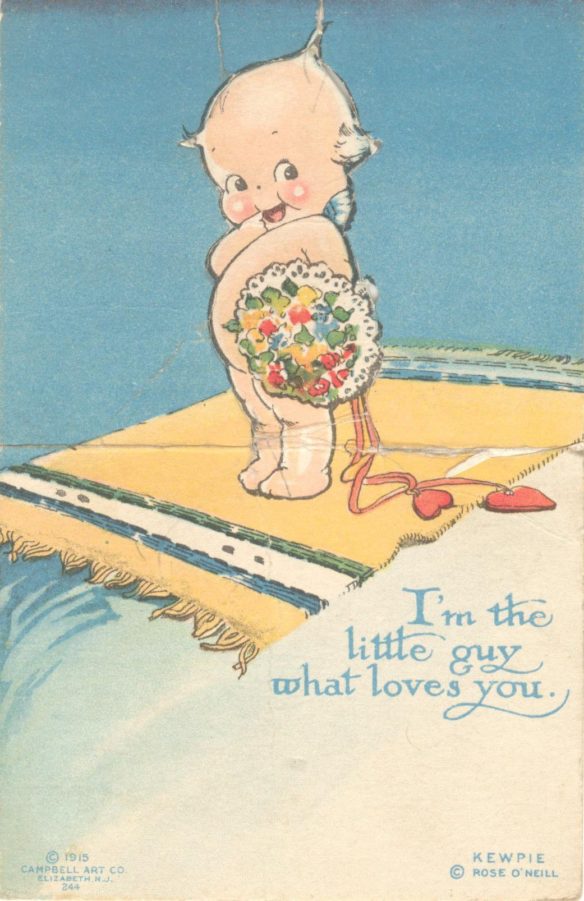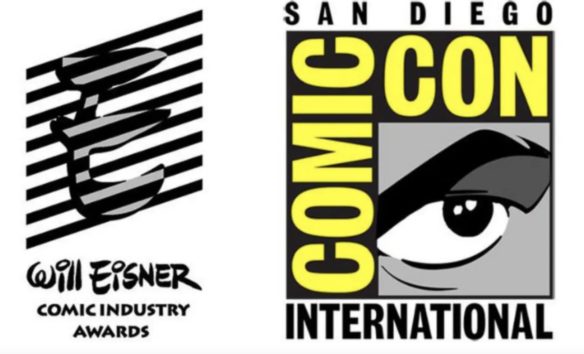
Comic-Con International has announced six individuals who will automatically be inducted to the Will Eisner Comic Awards Hall of Fame Nominees for 2022. These inductees include two deceased comics artists: EC founder/publisher Max Gaines (who devised the first four-color, saddle-stitched newsprint comic in 1933) and writer Mark Gruenwald (legendary Marvel Comics editor); two pioneers of the comics medium: British illustrator Marie Duval (co-creator in 1867 of the British cartoon character “Alley Sloper,” considered the first recurring cartoon character); cartoonist Rose O’Neill (creator of The Kewpies in 1912) and two living legends: Filipino American artist Alex Niño (DC, Marvel, Warren, Heavy Metal etc.) and artist P. Craig Russell (best known for Elric, his adaptations of opera to graphic novels, and his collaborations with Neil Gaiman, including on The Sandman, Coraline, American Gods, and Norse Mythology).
The judges have also chosen 17 nominees from whom voters will select 4 to be inducted in the Hall of Fame this summer. These nominees are Howard Chaykin, Gerry Conway, Kevin Eastman, Steve Englehart, Moto Hagio, Larry Hama, Jeffrey Catherine Jones, David Mazzucchelli, Jean-Claude Mézières, Grant Morrison, Gaspar Saladino, Jim Shooter, Garry Trudeau, Ron Turner, George Tuska, Mark Waid, and Cat Yronwode. More information on the nominees can be found here.
The 2022 Eisner Awards judging panel consists of comics writer/editor Barbara Randall Kesel, author/art historian Kim Munson, writer/editor/journalist Rik Offenberger, librarian Jameson Rohrer, comics journalist/historian Jessica Tseang, and retailer Aaron Trites.
The Eisner Hall of Fame trophies will be presented in a gala awards ceremony to be held during Comic-Con on the evening of July 22.
JUDGES’ CHOICES
Max Gaines (1894–1947)
In 1933, Max Gaines devised the first four-color, saddle-stitched newsprint pamphlet, a precursor to the color-comics format that became the standard for the American comic book industry. He was co-publisher (with Jack Liebowitz) of All-American Publications, a seminal comic book company that introduced such enduring fictional characters as Green Lantern, Wonder Woman, and Hawkman. He went on to found Educational Comics, producing the series Picture Stories from the Bible. He authored one of the earliest essays on comic books, a 1942 pamphlet titled Narrative Illustration, The Story of the Comics. After Gaines’ death (in a motorboating accident) in 1947, Educational Comics was taken over by his son Bill Gaines, who transformed the company (now known as EC Comics) into a pioneer of horror, science fiction, and satirical comics.
Mark Gruenwald (1953–1996)
Mark Gruenwald was hired by Marvel Comics in 1978 and stayed there until his death. During his tenure, he worked on a variety of books before becoming their executive editor and keeper of continuity for much of the 1980s. Gruenwald had a knack for remembering every bit of minutia about Marvel Comics. The publisher even opened up a challenge for readers to stump him but had to discontinue it when it became clear nobody could beat him. Gruenwald is most recognized for his work on a new team of heroes known as the Squadron Supreme. The Squadron’s characters had been around, but Gruenwald decided to focus on a new set of the heroes in an alternate reality. The Squadron Supreme received a 12-issue miniseries and is considered a precursor to highly popular deconstructionist superhero parables like Watchmen, Kingdom Come, and The Boys. Sadly, Gruenwald died of heart failure in 1996. He had long told his wife he wanted his ashes to be a part of his work. When Squadron Supreme was collected into a trade paperback, his ashes were mixed into the ink.
Alex Niño
Alex Niño was among the Philippine comics artists recruited for U.S. comic books by DC Comics editor Joe Orlando and publisher Carmine Infantino in 1971. Niño’s earliest DC work was drawing stories for House of Mystery, Weird War Tales, and other supernatural anthologies, as well as the jungle-adventure feature “Korak” in Tarzan. He moved to the U.S. in 1974. Over the next several decades, Niño drew all types of stories for DC, Marvel, Warren (Creepy, Eerie, Vampirella), Heavy Metal, Byron Preiss, Dark Horse Comics, and other publishers. Starting in the 1980s, Niño branched out into movies and video games, doing design work and concept art for Hanna-Barbera, Sega, and Walt Disney Pictures (Mulan and Atlantis). Niño received an Inkpot Award in 1976.
Craig Russell
Craig Russell has spent 50 years producing graphic novels, comic books, and illustrations. He entered the comics industry in 1972 as an assistant to artist Dan Adkins. After establishing a name for himself at Marvel on Killraven,Dr. Strange, and Elric, Russell began working on more personal projects, such as adaptations of operas by Mozart (The Magic Flute), Strauss (Salome), and Wagner (The Ring of the Nibelung). Russell is also known for his Fairy Tales of Oscar Wildeseries and his graphic novel adaptations of Neil Gaiman’s The Sandman: The Dream Hunters, Coraline, Murder Mysteries, and American Gods. His most recent project has been Gaiman’s Norse Mythology for Dark Horse. Russell received an Inkpot Award in 1993 and has won several Harvey and Eisner awards.
Pioneers
Marie Duval (1847–1890)
“Marie Duval” was born Isabelle Emilie Louisa Tessier in Marleybone, London in 1847. Tessier was one of the first female cartoonists in Europe. Her fame rests on her contributions to the Ally Sloper comic pages created with her husband Charles Henry Ross in the comic periodical Fun, and reprinted in a shilling book, Ally Sloper: A Moral Lesson (full title: Some Playful Episodes in the Career of Ally Sloper late of Fleet Street, Timbuctoo, Wagga Wagga, Millbank, and elsewhere with Casual References to Ikey Mo) in November 1873. This work is often called “the first British comic book.” The idea of a recurring, familiar cartoon character—so basic to comics and cartoons as we know them now—appears to have begun with Ally Sloper. The wildly popular character (a hard-drinking working class shirker) is thought to have inspired both Charlie Chaplin’s Tramp persona and W. C. Fields. Besides Ally Sloper, Marie Duval drew a range of comic fantasies (“caricatures”) for the magazine Judy, a Victorian rival to Punch.
Rose O’Neill (1874–1944)
Rose O’Neill was an American cartoonist and writer who, at a young age, became the best-known and highest-paid female commercial illustrator in the United States. A four-panel comic strip by O’Neill were featured in a September 19, 1896, issue of Truth magazine, making her the first American woman to publish a comic strip. She earned her international fame and fortune by creating the Kewpie, the most widely known cartoon character until Mickey Mouse. Her Kewpie cartoons, which made their debut in a 1909 issue of Ladies’ Home Journal, were made into bisque dolls in 1912 by J. D. Kestner, a German toy company. The dolls became immediately popular and are considered to be one of the first mass-marketed toys in the United States.
2022 NOMINEES
Howard Chaykin
After working as an assistant for the likes of Gil Kane, Wally Wood, Neal Adams, and Gray Morrow, in the early 1970s Howard Chaykin became a freelancer for such publishers as Marvel, DC, Warren, and Heavy Metal. In 1974, he created “Cody Starbuck” for Star*Reach. Chaykin pioneered the graphic novel with Alfred Bester’s The Stars My Destination and Samuel R. Delaney’s Empire, among others. In 1977, prior to the movies, he drew the first Star Wars comics with scripts by Roy Thomas. In 1983, he created the hit series American Flagg! at First Comics. His 1980s output included Black Kiss (Vortex), The Shadow and Blackhawk (DC) and his postmodern graphic novel Time2 at First. Subsequent projects have included Twilight, Power and Glory, American Century, Mighty Love, The Divided States of Hysteria, and Hey, Kids! Comics!
Gerry Conway
Gerry Conway is best known for co-creating the Marvel Comics vigilante The Punisher (with artist Ross Andru) and Ms. Marvel (with John Buscema), and for scripting the death of the character Gwen Stacy during his long run on The Amazing Spider-Man. He is also known for co-creating DC Comics’ Firestorm, Power Girl, Killer Croc, and Jason Todd. HE wrote Justice League of America for eight years and for scripted the first major, modern-day intercompany crossover, Superman vs. the Amazing Spider-Man.
Kevin Eastman
Writer/artist/publisher Kevin Eastman co-created Teenage Mutant Ninja Turtles with Peter Laird. The duo published the comic themselves starting in 1984, under the imprint Mirage Studios. The Turtles quickly made the leap to other media and went on to star in multiple movies, animated TV series, and toy lines over the years. In 1990 Eastman founded Tundra Publishing, which funded and published creator-owned comics by talent such as Alan Moore, Melinda Gebbie, Eddie Campbell, and Mike Allred, until 1993. Eastman also owned Heavy Metal magazine for more than 20 years, until 2014, and he continued to serve as its publisher until 2020.
Steve Englehart
Steve Englehart began writing for Marvel Comics in 1971, with long runs on Captain America, The Hulk, The Avengers, Dr. Strange, and a dozen other titles, co-creating the characters Shang-Chi, Star-Lord, and Mantis along the way. He was finally hired away by DC Comics to be their lead writer and revamp their core characters (Superman, Batman, Wonder Woman, Flash, and Green Lantern). He did, but he also wrote a solo Batman series with art by Walt Simonson and Marshall Rogers (immediately dubbed the “definitive” version) that later became Warner Brothers’ first Batman film. In 1983 he created Coyote, for Marvel’s Epic imprint. Other projects he owned (Scorpio Rose, The Djinn) were mixed with company series (Green Lantern, Silver Surfer, Fantastic Four). In 1992 Steve was asked to co-create a comics pantheon called the Ultraverse. One of his contributions, The Night Man, became not only a successful comics series, but also a television show. That led to more Hollywood work, including animated series such as Street Fighter, GI Joe, and Team Atlantis for Disney.
Moto Hagio
Moto Hagio is one of a group of women who broke into the male-dominated manga industry and pioneered the shōjo (girls’ comics) movement in the early 1970s. Hagio’s 1974 work Heart of Thomas, inspired by the 1964 film This Special Friendship, was one of the early entries in the shōnen-ai (boys in love) subgenre. Hagio’s linework and dramatic imagery have influenced many manga artists, and she helped shape the style of emotional and symbolic backgrounds that many manga artists draw today. Her major works include A Drunken Dream, They Were Eleven, and Otherworld Barbara. She’s won the Japanese Medal of Honor with the Purple Ribbon (the first woman comics creator to do so), received Japan’s SF Grand Prize, the Osamu Tezuka Culture Award Grand Prize, and an Inkpot Award, among other accolades.
Larry Hama
Larry Hama is a writer/artist/editor/actor who is best known as the writer of Marvel’s G.I. Joe: A Real American Hero, G.I. Joe: Special Missions, and Wolverine comics in the ’80s and ’90s. He has also written, edited, or drawn for Avengers, Conan, Batman, Wonder Woman, X-Men, Spider-Man, and dozens more. His illustrations and cartoons have appeared in National Lampoon, Esquire, New York and Rolling Stone. His most recent novel is The Death of Captain America. He also scripted Batman Shadow of the Bat and Wonder Woman for DC Comics’ Convergence Event, as well as Call of Duty: Black Ops III for Dark Horse and of G.I. Joe: A Real American Hero for IDW.
Jeffrey Catherine Jones
Jones (1944–2011) began creating comics in 1964. While attending Georgia State College, Jones met fellow student Mary Louise Alexander; the two began dating and were married in 1966. After graduation, the couple moved to New York City but split up in the early 1970s. (Writer/editor Louise Jones Simonson was inducted into the Eisner Hall of Fame in 2020.) In New York Jones found work drawing for King Comics, Gold Key, Creepy, Eerie, and Vampirella, as well as Wally Wood’s Witzend. Jones painted covers for more than 150 books, including the Ace paperback editions of Fritz Leiber’s Fafhrd and the Gray Mouser series and Andre Norton’s Postmarked the Stars, The Zero Stone, Uncharted Stars, and many others. In the early 1970s when National Lampoon began publication, Jones had a strip in it called Idyl. From 1975 to 1979 Jones shared workspace with Bernie Wrightson, Barry Windsor-Smith, and Michael Wm Kaluta, collectively named The Studio. By the early 1980s Jones had a recurring strip in Heavy Metal titled I’m Age. In the late 1990s, Jones started taking female hormones and had sex reassignment surgery. She passed away in May of 2011.
David Mazzucchelli
David Mazzucchelli started working in comics in the early 1980s, first at Marvel Comics where he became the regular artist on Daredevil. He worked with writer Denny O’Neil and culminated his work on this title with the Daredevil: Born Again story arc, written by Frank Miller. He collaborated with Miller again on Batman: Year One, considered one of the best Batman stories ever produced. Mazzucchelli moved on to focus on more personal projects, including his own independent anthology, Rubber Blanket and an adaptation of Paul Auster’s City of Glass. In 2009, Pantheon Books published Mazzucchelli’s graphic novel, Asterios Polyp, which won the Los Angeles Times Book Prize and three Eisner Awards.
Jean-Claude Mézières
Jean-Claude Mézières (1938–2022) was a French comic strip artist and illustrator. Educated at the Institut des Arts Appliqués, upon graduation he worked as an illustrator for books and magazines as well as in advertising. A lifelong interest in the Wild West led him to travel to the United States in 1965 in search of adventure as a cowboy, an experience that would prove influential on his later work. Returning to France, Mézières teamed up with his childhood friend, Pierre Christin, to create Valérian and Laureline, the popular, long-running science fiction comics series for which he is best known and which has proved to be influential on many science fiction and fantasy films, including Star Wars. Mézières has also worked as a conceptual designer on several motion picture projects—most notably the 1997 Luc Besson film, The Fifth Element—as well as continuing to work as an illustrator for newspapers, magazines and in advertising. Mézières has received international recognition through a number of prestigious awards, most notably the 1984 Grand Prix de la ville d’Angoulême award.
Grant Morrison
Grant Morrison started writing comics in the early 1980s on various titles for British publishers, including Warrior, Dr. Who, and 2000 AD. Morrison’s first U.S. hit was Animal Man for DC, followed by Doom Patrol. In 1989 DC published Morrison and Dave McKean’s highly successful graphic novel Arkham Asylum: A Serious House on Serious Earth. In the 1990s Grant produced several titles for DC’s Vertigo line, including The Invisibles, Sebastian O, Flex Mentallo, The Mystery Play, and Kill Your Boyfriend. Also at DC, they wrote JLA, The Flash, and DC One Million. In 2000–2001 Morrison moved over to Marvel, writing Marvel Boy, Fantastic Four 1234, and New X-Men. Grant’s DC works in recent decades include The Filth, W3, Seaguy, Seven Soldiers, Final Crisis, the award-winning All-Star Superman (with Frank Quitely), The Multiversity, the graphic novel JLA: Earth 2, and the ongoing Batman title. Morrison’s most recent projects have included Happy!, and Nameless for Image, 2015, Klaus and Proctor Valley Road for BOOM!, and Green Lantern, Wonder Woman: Earth One, and Superman and The Authority for DC.
Gaspar Saladino
Gaspar Saladino (1927–2016) worked for more than 60 years in the comics industry as a letterer and logo designer. According to former DC publisher Paul Levitz, “His work on Len Wein and Bernie Wrightson’s Swamp Thing run established a new level for what lettering could do to add to storytelling in periodical American comics, bringing more drama with his innovative style.” Saladino began as a letterer at DC in 1949. Titles he worked on included Justice League of America, The Flash, Strange Adventures, Mystery in Space, G.I. Combat, Hellblazer, and Superman vs. Muhammad Ali. He also designed and lettered the DC house ads and hundreds of covers. Among logos that Saladino designed were Green Lantern, House of Mystery, Batman, Swamp Thing, Teen Titans, Metal Men, Adam Strange, and Phantom Stranger. For Marvel he did the logos for The Avengers and Captain America and the Falcon, among others. He was active until around 2002.
Jim Shooter
At age 14, Shooter began selling stories to DC Comics, writing for both Action Comics and Adventure Comics. In January 1976, he joined the Marvel staff as an assistant editor and writer, and in 1978 he succeeded Archie Goodwin to become Marvel’s ninth editor-in-chief. Marvel enjoyed some of its best successes during Shooter’s nine-year tenure, including Chris Claremont and John Byrne’s run on the Uncanny X-Men, Byrne’s work on the Fantastic Four, Frank Miller’s series of Daredevil stories, and Walt Simonson’s crafting of Norse mythology with the Marvel Universe in Thor. Shooter also institutionalized creator royalties, starting the Epic imprint for creator-owned material in 1982; introduced company-wide crossover events, with Marvel Super Hero Contest of Champions and Secret Wars; and launched a new, albeit ultimately unsuccessful, line named New Universe, to commemorate Marvel’s 25th anniversary in 1986. Shooter left Marvel in 1987 and founded Valiant Comics. He and several of his co-workers went on to found short-lived Defiant Comics in early 1993, followed two years later by Broadway Comics.
Garry Trudeau
Trudeau attended Yale University, where he was a cartoonist and writer for The Yale Record. He also created a comic strip called Bull Tales, which moved to the Yale Daily News in 1969. Universal Press Syndicate bought the strip and started selling it nationwide to over 400 newspapers under the title Doonesbury. In his long career, Trudeau has made several political statements within his comics, and has been groundbreaking in dealing with topics like homosexuality in comic strips. He also has been a strong advocate of cartoonists’ rights. In 1975, Trudeau was the first comic strip artist to win the Pulitzer Prize, followed by the Rueben Award in 1996. Doonesbury was made into an animated short film in 1977 and a Broadway musical in 1984.
Ron Turner
Ron Turner founded Last Gasp in 1970: a San Francisco-based book publisher with a lowbrow art and counterculture focus. Over the last 52 years Last Gasp has been a publisher, distributor, and wholesaler of underground comix and books of all types. Although the company came onto the scene a bit later than some of the other underground publishers, Last Gasp continued publishing comix far longer most of its competitors. In addition to publishing notable original titles like Slow Death, Wimmen’s Comix, Binky Brown Meets the Holy Virgin Mary, Air Pirates, It Ain’t Me Babe, and Weirdo, it also picked up the publishing reins of important titles such as Zap Comix and Young Lust from rivals that had gone out of business. The company publishes art and photography books, graphic novels, manga translations, fiction, and poetry.
George Tuska
George Tuska (1916–2009) finished his studies at the National Academy School of Art at age 21. In 1939, he became assistant on the Scorchy Smith newspaper strip. At the same time, he joined the Iger-Eisner Studio, whe worked on stories for a variety of comic book titles, including Jungle, Wings, Planet, Wonderworld, and Mystery Men. In the 1940s, as a member of the Harry “A” Chesler Studio, he drew several episodes of Captain Marvel, Golden Arrow, Uncle Sam, and El Carim. After the war, he continued in the comics field with memorable stories for Charles Biro’s Crime Does Not Pay, as well as Black Terror, Crimebuster, and Doc Savage. He also became the main artist on Scorchy Smith from 1954 to 1959, when he took over the daily and Sunday Buck Rogers pages, which he continued until 1967. In the late 1960s, Tuska started working for Marvel, where he contributed to Ghost Rider, Planet of the Apes, X-Men, Daredevil, and Iron Man. He continued drawing superhero comics for DC, including Superman, Superboy, and Challengers of the Unknown. In 1978, along with José Delbo, Paul Kupperberg and Martin Pasko, Tuska started a new version of the daily Superman comic. Tuska worked on this series until 1993.
Mark Waid
Mark Waid got his start in the comics industry writing for Amazing Heroes and Comics Buyers’ Guide. In the mid-1980s he joined the staff of Amazing Heroes as a writer and editor. From there, he jumped to the big time, joining DC Comics as an editor in 1987, then went freelance in 1989. Hebecame the main writer on The Flash from 1992 through 2000, while also writing Captain America. In 1997, Waid teamed with Alex Ross for DC’s award-winning Kingdom Come. In 1999, he joined with several peers to form the short-lived Gorilla Comics, then became part of CrossGen, another start-up publisher. That was followed by a three-year run writing Fantastic Four. In 2003 Waid returned to DC for Superman: Birthright: The Origin of the Man of Steel. From August 2007 to December 2010, Waid served as editor-in-chief and later chief creative officer at BOOM! Studios; he is currently publisher for Humanoids.
Catherine “Cat” Yronwode
In 1980, Cat Yronwode worked as an editor for Ken Pierce Publishing, editing and writing introductions to a line of comic strip reprint books. She also began a long-running column titled “Fit to Print” for the Comics Buyer’s Guide. The column led to freelance editing jobs at Kitchen Sink Press, for which she wrote The Art of Will Eisner in 1981. In 1982 she began a partnership with Dean Mullaney, who with his brother Jan had co-founded Eclipse Enterprises. With Yronwode as editor-in-chief during a period of expanding attention to the artform, Eclipse published many innovative works and championed creators’ rights in a field which at the time barely respected them. During her tenure, Eclipse published such works as Miracleman by Alan Moore and Neil Gaiman, The Rocketeer by Dave Stevens, Zot! by Scott McCloud, and The Magic Flute by P. Craig Russell. In 1985, Eclipse published Women and the Comics, a pioneering book on the history of female comic strip and comic book creators, by Yronwode and Trina Robbins.
Discover more from File 770
Subscribe to get the latest posts sent to your email.

